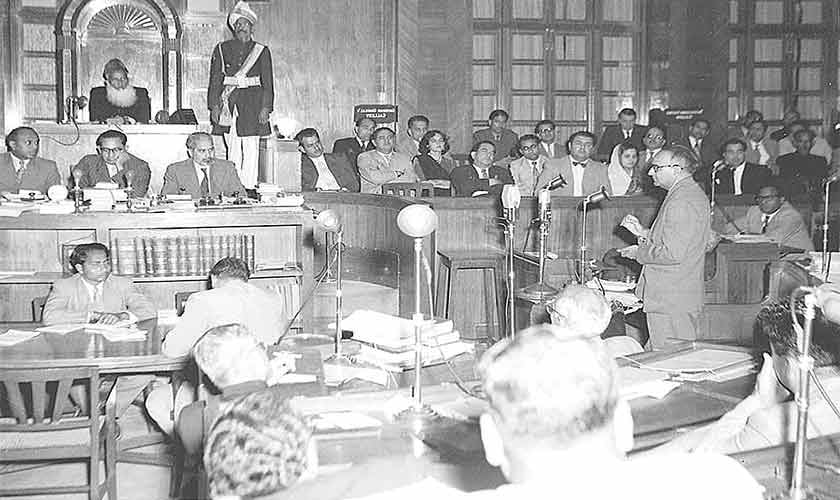The creation of Pakistan, the Two-Nation Theory proposes, shows that Hindus and Muslims are separate nations incapable of coexisting. This claim prompts several important inquiries:
1. What was the significant role of the Muslim-majority provinces in the establishment of Pakistan?
2. What motivated Jogendranath Mandal, a Dalit leader from Bengal, to advocate for the establishment of Pakistan?
3. What were the reasons for Abul Ala Maududi and other prominent Islamic religio-political parties to oppose the Pakistan Movement?
4. What factors contributed to the separation of East Pakistan from West Pakistan within 24 years?
5. What factors contributed to the nine-year duration required to establish Pakistan’s first constitution, given that the implementation of Islamic laws could have been initiated sooner?
6. What were the reasons behind Quaid-i-Azam Muhammad Ali Jinnah’s appointment of Jogendranath Mandal as the inaugural chairman of the Constituent Assembly and subsequently as the first minister for law and labour?
Let us try to address these important questions.
### The Role of Muslim-Majority Provinces in Pakistan’s Formation
The contribution of Muslim-majority provinces, especially Punjab, to the establishment of Pakistan has been extensively studied in academic literature. Historians examining Pakistani nationalism contend that Punjab’s strategic significance during the Pakistan movement played a crucial role in the All-India Muslim League’s (AIML) success in the 1945-46 general elections.
During the 1946 elections in Punjab, the AIML won 73 of the 175 seats — all 73 were Muslim seats. These seats were secured primarily by notable landlords who allied themselves with the AIML. It has been suggested that this partnership was more a landlord-protection strategy against potential land reforms proposed by the Indian National Congress rather than purely religious nationalism.
Khyber Pakhtunkhwa, formerly known as the North-West Frontier Province, stood out as India’s sole Muslim-majority province without a Muslim League cabinet. Its government strongly resisted the formation of Pakistan, highlighting the complex regional dynamics involved.
### Jogendranath Mandal and Dalit Participation in the Pakistan Movement
Bengali Hindus, notably Dalits under the leadership of Jogendranath Mandal, joined the Pakistan Movement expecting a new political framework addressing systemic inequalities. The caste system curtailed individual freedom, while Islamic equality offered an alternative vision of social justice.
Their participation illustrates a Marxist perspective on class struggle — where the downtrodden seek emancipation through structural and social change, rather than religion or nationalism alone. This suggests that social status challenges, rather than merely religious identification, drove some demand for a new state.
Religion did help gain support in some areas, but the movement’s core struggle was social. Many participants linked the idea of Pakistan simultaneously to religious identity and resistance against colonial and feudal oppression.
### Opposition from Jamaat-i-Islami and Abul Ala Maududi
The Jamaat-i-Islami, led by Abul Ala Maududi, opposed the partition of India because they viewed it as contradictory to the concept of the ummah — the worldwide community of Muslims. Maududi argued that dividing the subcontinent along arbitrary physical borders could weaken the spiritual and cultural ties between Muslims.
For Jamaat-i-Islami, partition was not just a political division but a split of a group’s religious and cultural identity, thereby challenging the very idea of the ummah’s unity.
### Factors Leading to the Separation of East Pakistan in 1971
Many scholars argue that the establishment of Bangladesh, or the separation of East Pakistan from West Pakistan within 24 years, resulted from multiple factors.
Long-term causes include the mistreatment of the Bengali language and provincial autonomy issues. Short-term factors involved the results of the 1970 general elections. Immediate triggers such as the Searchlight Operation and the involvement of foreign powers like India and the USSR also played significant roles.
This multi-causal interpretation contrasts with the often mono-causal narratives about the 1947 partition. A comparative analysis of both partitions, using a consistent theoretical and methodological framework, could provide a more thorough understanding of these complex historical events.
### Delayed Constitution and Debates Over Pakistan’s Political Structure
From its inception rooted in the Two-Nation Theory, Pakistan faced questions regarding the implementation of Islamic laws and the nation’s governance structure.
The nine-year delay in establishing Pakistan’s first constitution sparked debates on crucial issues such as:
– Whether the state should be theocratic or secular
– Parliamentary versus presidential democracy
– Federal versus unitary system
– The division of power between a strong federation and autonomous provinces
– Whether the legislature should be bicameral or unicameral
These discussions reflect the complexities involved in shaping Pakistan’s identity and political institutions in its early years.
### Quaid-i-Azam’s Appointment of Jogendranath Mandal
Quaid-i-Azam Muhammad Ali Jinnah appointed Jogendranath Mandal, a Hindu Dalit leader, as the inaugural chairman of the Constituent Assembly and later as the first minister for law and labour.
This appointment prompts critical examination, especially considering the Two-Nation Theory underpinning Pakistan’s creation. Choosing a Hindu for such prominent roles in a newly formed Muslim state raises questions about the practical understanding and application of the theory.
### Conclusion
Analyzing these questions reveals that Pakistan’s creation in 1947, much like the formation of Bangladesh in 1971, was shaped by a complex array of interconnected factors rather than a singular cause.
Both partitions merit examination through a unified analytical framework to better comprehend the intricate social, political, and cultural dynamics at play.
Moreover, the foundation of Pakistan can also be linked to class struggle, especially in Bengal, rather than being driven solely by religious nationalism. Marginalized and disenfranchised groups sought better living conditions within a vision of an Islamic socialist state, reflecting broader aspirations that mobilized various segments of society during the Pakistan Movement.
https://www.thenews.com.pk/tns/detail/1346769-historys-unanswered-questions
